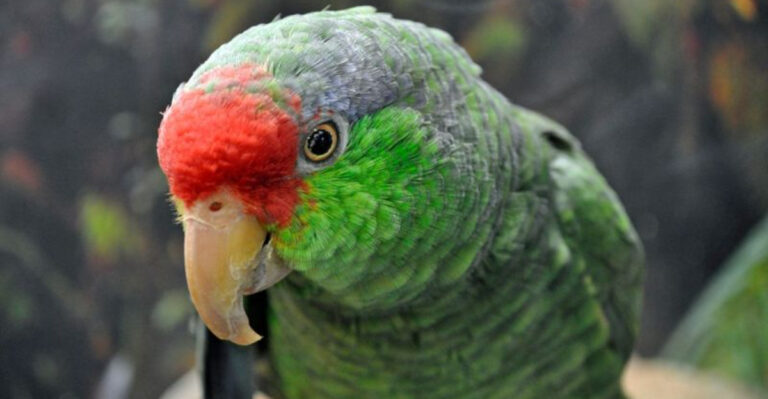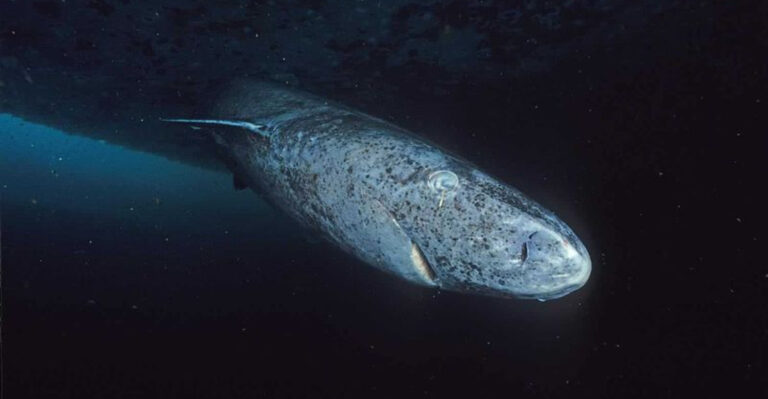Learn More About Manta Rays, The Majestic Giants Gliding Through The Oceans
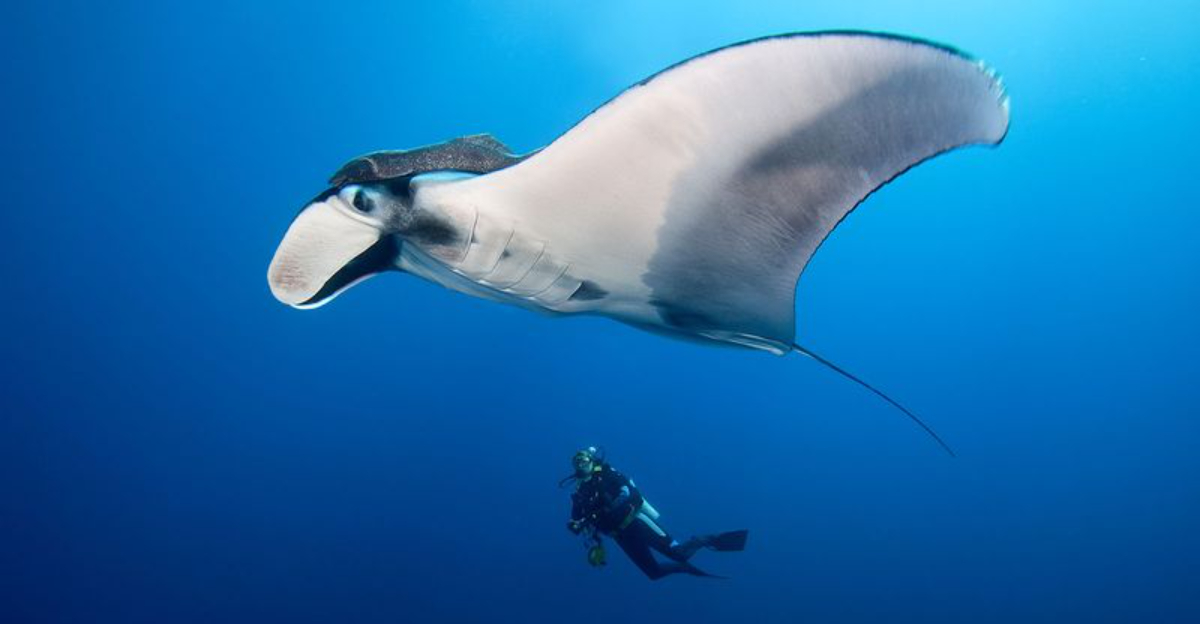
Manta rays are some of the most fascinating creatures swimming through our oceans today. With their graceful wing-like fins and enormous size, these gentle giants captivate divers and marine enthusiasts worldwide.
Unlike their stingray cousins, mantas are harmless to humans and possess remarkable intelligence that sets them apart from other fish. Let’s explore twelve amazing facts about these underwater marvels that continue to surprise scientists and ocean lovers alike.
Manta Rays Are The Largest Rays In The Ocean
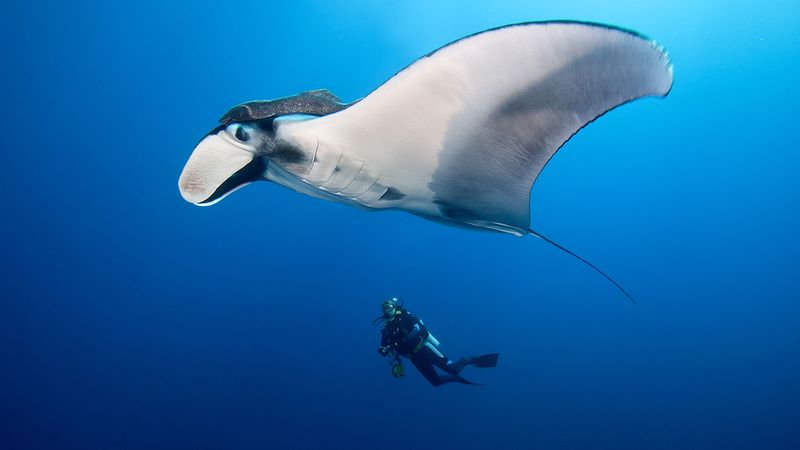
Nothing quite prepares you for your first manta ray encounter. These colossal creatures dwarf other ray species with their impressive bulk and wingspan. When a manta glides overhead, blocking out the sunlight like an underwater eclipse, even experienced divers feel humbled.
Weighing up to 3,000 pounds (1,350 kg), these ocean behemoths can reach body lengths of 23 feet (7 meters) from wing tip to wing tip. Despite their massive size, they move with ballet-like precision through the water.
Female mantas typically grow larger than males, following a pattern common among many marine animals. Their enormous size helps protect them from most predators except the largest sharks and killer whales.
Their Wingspans Can Reach Up To 7 Metres Across
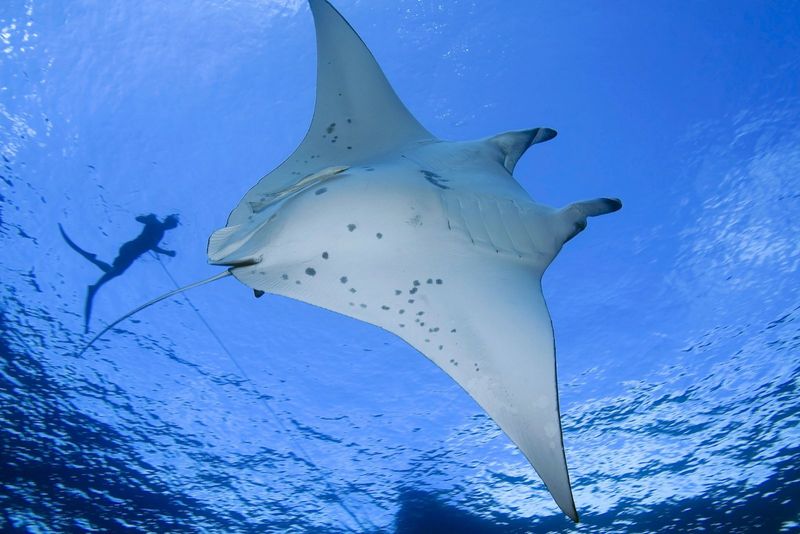
Imagine standing beside a small car – that’s roughly the wingspan of a fully grown manta ray! These magnificent creatures boast fins that can stretch up to 7 meters (23 feet) from tip to tip, creating an awe-inspiring silhouette against the ocean blue.
Such enormous wingspans serve multiple purposes. The obvious benefit is powerful propulsion, allowing mantas to cruise effortlessly for long distances. They’re also remarkably agile for their size, capable of executing graceful barrel rolls and sudden turns.
When fishing vessels spot these distinctive shadows from above, they often mistake them for much larger creatures due to their impressive width. Sailors throughout history have spun tales of sea monsters based on these sightings.
Despite Their Size, Manta Rays Are Gentle Filter Feeders
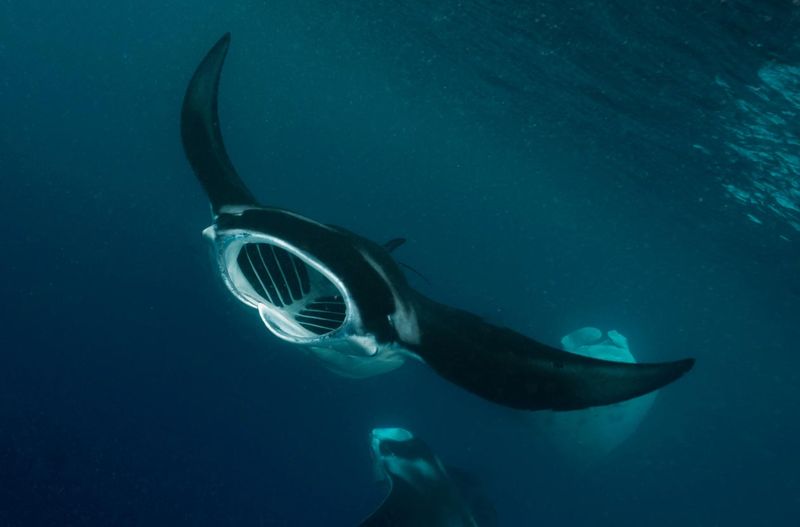
Those massive bodies need fuel, but mantas aren’t the terrifying predators their size might suggest. Armed with neither teeth nor stingers, these gentle giants feast exclusively on tiny organisms like zooplankton, krill, and microscopic fish eggs.
Swimming with their cavernous mouths wide open, they process approximately 60 cubic meters of seawater per hour! Special gill plates strain out the nutritious particles while water flows back out through their gills. A single manta can consume up to 60 pounds of plankton daily.
Feeding frenzies occur when plankton concentrates in one area, drawing dozens of mantas together in spectacular underwater ballets. They’ll often form feeding chains, following one another through plankton-rich waters for maximum efficiency.
They Use Cephalic Fins Like Scoops To Funnel Plankton
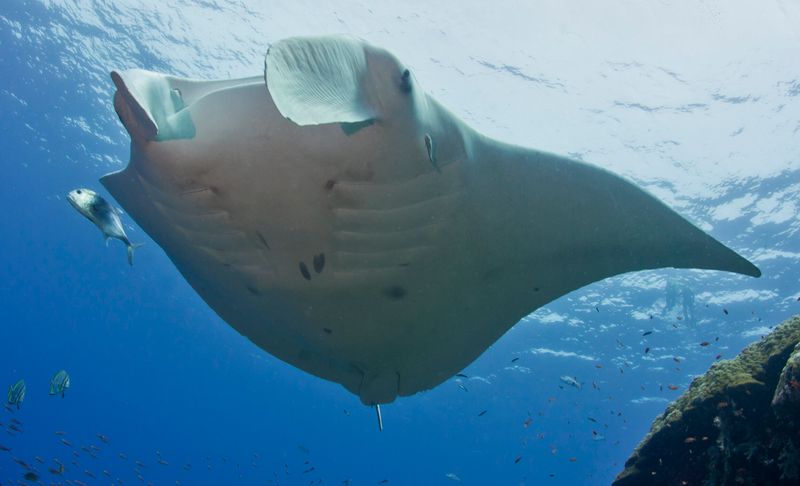
Those distinctive horn-like appendages on a manta’s head aren’t just for show – they’re sophisticated feeding tools called cephalic fins. When not feeding, these fins roll up tightly, giving mantas their devilish nickname. But during mealtime, they unfurl dramatically into food-funneling scoops.
Watch a feeding manta and you’ll witness an ingenious process. The cephalic fins extend forward like underwater hands, creating vortices that direct plankton-rich water straight into their gaping mouths. This specialized adaptation allows them to harvest maximum nutrition with minimal effort.
Scientists have observed mantas using different feeding techniques depending on plankton density. In sparse areas, they swim with mouths wide open, while in plankton-rich zones, they employ these cephalic fins with remarkable precision.
Manta Rays Can Recognise Themselves In Mirrors – A Rare Skill
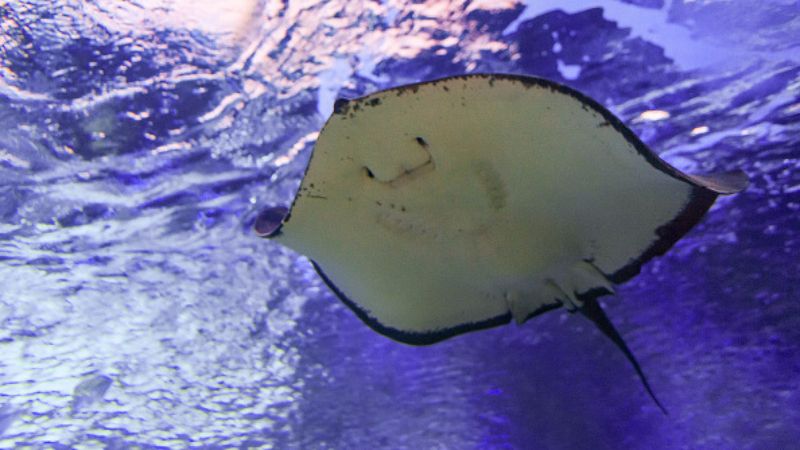
Few animals possess the cognitive ability to recognize their own reflection – a skill once thought unique to humans, great apes, and dolphins. Astonishingly, manta rays joined this exclusive club when researchers observed them examining themselves in mirrors without trying to interact with their reflection as if it were another animal.
During experiments, mantas would repeat specific movements while facing mirrors, seemingly checking their own appearance. This self-awareness suggests cognitive abilities far beyond what we typically expect from fish.
The implications are profound. Self-recognition indicates complex brain function, emotional intelligence, and potentially even a form of consciousness. For marine biologists, this discovery has revolutionized our understanding of fish intelligence and opened new questions about the inner lives of these ocean wanderers.
They Have The Largest Brain Of Any Fish Relative To Body Size
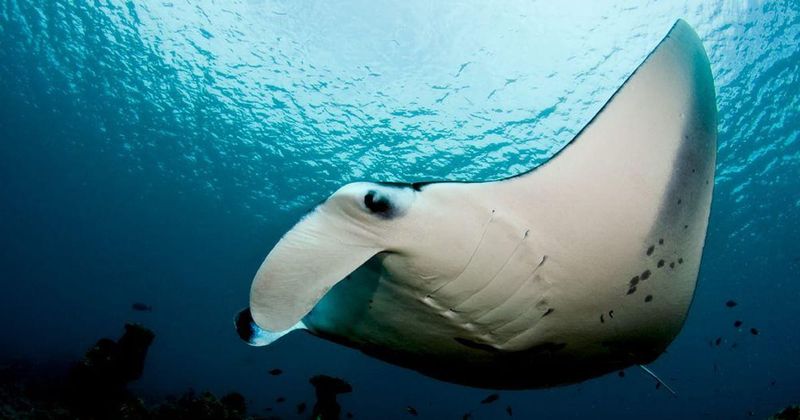
Beneath those wide, expressive eyes lies an extraordinarily developed brain. Mantas possess the largest brain-to-body ratio of any fish in the sea – a surprising fact given that fish aren’t typically celebrated for their intelligence. Their brain structure includes enlarged areas for learning, problem-solving, and social interaction.
Researchers studying wild populations have documented complex social behaviors, including apparent friendships and recognition of individual divers who regularly visit their territories. They’ve been observed working cooperatively to herd fish and even playing with bubbles produced by scuba divers.
Memory seems particularly developed in mantas. They remember productive feeding sites and return to them seasonally, navigating across vast ocean distances with remarkable precision. This cognitive sophistication has prompted many scientists to advocate for stronger protection of these sentient ocean dwellers.
Manta Rays Travel Thousands Of Miles In Ocean Currents
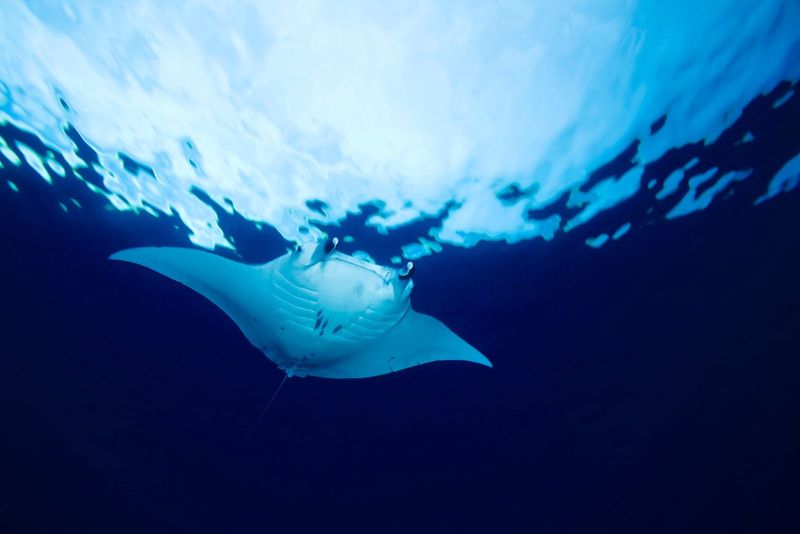
Nomads of the deep blue, manta rays embark on epic migrations that would exhaust most ocean travelers. Satellite tracking has revealed journeys spanning thousands of miles, with some individuals crossing international boundaries and navigating through multiple ocean ecosystems without hesitation.
Unlike many migratory species, mantas don’t follow strict seasonal patterns. Their travels appear motivated by shifting food availability, reproductive opportunities, and ocean temperature changes. Remarkably, they achieve these marathon swims while barely resting, gliding efficiently through currents that act like underwater highways.
One tagged female manta, affectionately named “Amelia” by researchers, traveled over 1,100 miles from Ecuador’s coast to Colombia’s Malpelo Island in just 42 days. These extensive migrations make conservation particularly challenging, as mantas regularly swim beyond protected areas into fishing zones.
These Ocean Giants Are Often Seen Leaping From The Water
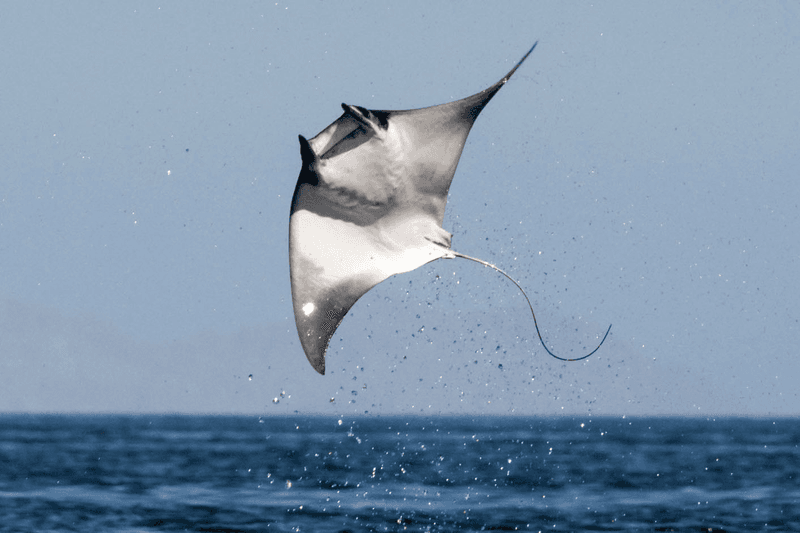
Spectacular breaches are among the most breathtaking manta behaviors witnessed by lucky observers. Without warning, these massive rays rocket from the depths and launch their entire bodies several feet above the waves before crashing back with tremendous splashes. A full-grown manta breaching creates a spectacle that rivals even the famous jumps of humpback whales.
Marine biologists debate the purpose behind these acrobatics. Leading theories suggest breaching helps remove parasites, communicates with other mantas during mating season, or simply expresses playfulness. The loud smack upon re-entry might also serve as a sound signal to distant pod members.
Some populations, particularly those around Mexico’s Sea of Cortez, have become famous for their frequent aerial displays. Tour boats specifically seek out these “flying mantas” for awestruck visitors.
There Are Two Main Species – Reef And Giant Oceanic Mantas
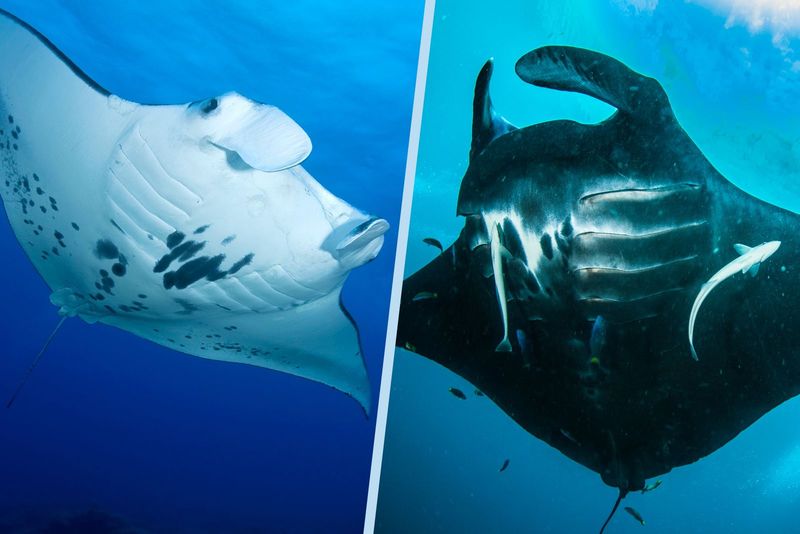
Until 2009, scientists believed all mantas belonged to a single species. Genetic research revealed two distinct types with different lifestyles, appearances, and habitats. Reef mantas (Mobula alfredi) are the slightly smaller cousins, typically reaching 18 feet across and preferring coastal waters around coral reefs and island groups.
Giant oceanic mantas (Mobula birostris) live up to their name, growing larger and venturing far into open ocean environments. While both species share the distinctive black-and-white coloration, close inspection reveals differences. Reef mantas typically display Y-shaped shoulder markings, while oceanic mantas show T-shaped patterns.
Their behaviors differ too. Reef mantas form more stable social groups and establish cleaning stations where smaller fish remove their parasites. Oceanic mantas roam more widely and dive to astonishing depths exceeding 1,000 meters.
They Pose No Threat To Humans And Have No Stinger
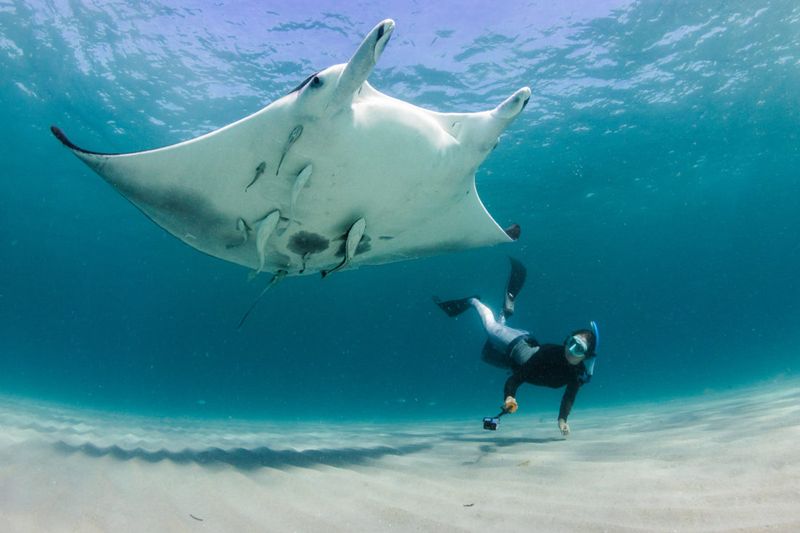
Contrary to what thriller movies might suggest, encountering a manta ray underwater is cause for wonder, not fear. Unlike their relatives the stingrays, mantas evolved without the defensive barbed tail that made Steve Irwin’s encounter so tragically famous. Their tails are smooth, whip-like appendages used primarily for balance.
These peaceful giants show no aggression toward humans. In fact, many divers report mantas approaching them with apparent curiosity, sometimes hovering overhead or circling slowly as if studying these strange bubble-blowing visitors. Their massive mouths are specialized for tiny prey, not for biting.
The greatest danger in manta encounters actually flows the other way – humans sometimes damage mantas by touching or riding them, disrupting their protective mucus layer and causing stress or injury to these gentle creatures.
Giant Mantas Can Be Twice The Size Of A Great White Shark In Width
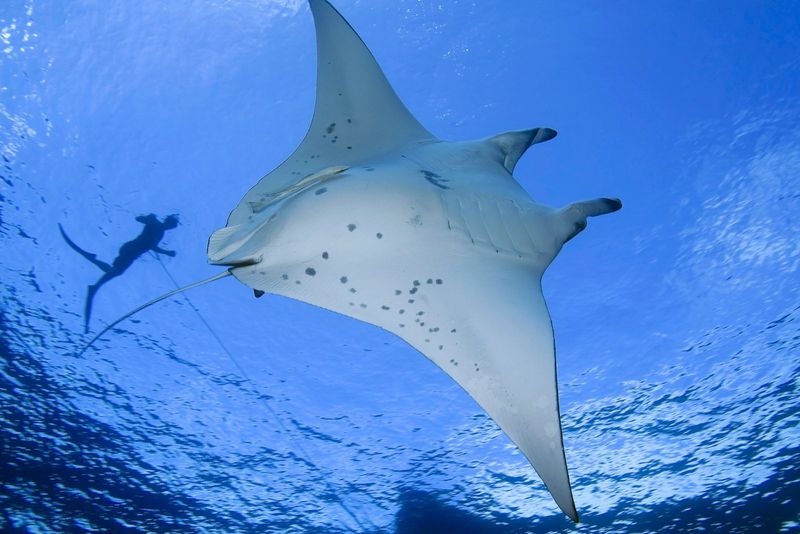
Picture a great white shark – now imagine an animal with twice that width. That’s the reality of encountering a fully grown oceanic manta ray! While great whites typically reach 15-16 feet in length, giant mantas spread their “wings” up to 29 feet across, creating a shadow that dwarfs most ocean predators.
This massive wingspan makes mantas the undisputed giants of the ray world. When viewed from below, their enormous silhouettes can temporarily block out the sun, creating an eclipse-like effect that divers describe as both humbling and awe-inspiring.
Despite outspanning sharks in width, mantas have evolved a different body plan focused on gliding efficiency rather than forward speed. Their incredible size developed not for hunting but for covering vast distances while filtering massive volumes of water for tiny food particles.
Their Wingspans Are Larger Than A Bull Shark Is Long
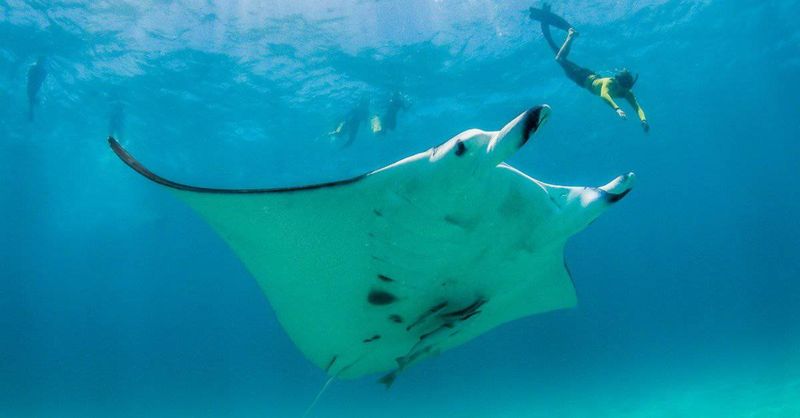
Bull sharks, notorious for their aggressive nature and substantial 11-foot length, look positively diminutive when swimming alongside a full-grown manta ray. A manta’s “wingspan” can easily exceed 20 feet across – nearly double the entire length of these formidable sharks.
This remarkable size comparison helps visualize just how massive these rays truly are. When a manta ray passes overhead, its pectoral fins extend wider than a small boat. Underwater photographers often struggle to capture their entire form in a single frame without specialized wide-angle equipment.
Fascinatingly, despite this enormous size advantage, mantas remain vulnerable to bull shark attacks. The sharks target the rays’ fleshy pectoral fins, demonstrating that in the ocean, size alone doesn’t determine the predator-prey relationship. Speed, agility and hunting strategy often matter more than sheer dimensions.

